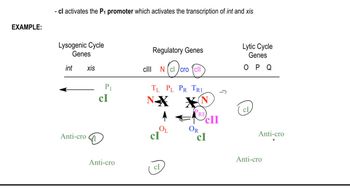Tryptophan regulates the trp operon by doing what?
Table of contents
- 1. Introduction to Genetics51m
- 2. Mendel's Laws of Inheritance3h 37m
- 3. Extensions to Mendelian Inheritance2h 41m
- 4. Genetic Mapping and Linkage2h 28m
- 5. Genetics of Bacteria and Viruses1h 21m
- 6. Chromosomal Variation1h 48m
- 7. DNA and Chromosome Structure56m
- 8. DNA Replication1h 10m
- 9. Mitosis and Meiosis1h 34m
- 10. Transcription1h 0m
- 11. Translation58m
- 12. Gene Regulation in Prokaryotes1h 19m
- 13. Gene Regulation in Eukaryotes44m
- 14. Genetic Control of Development44m
- 15. Genomes and Genomics1h 50m
- 16. Transposable Elements47m
- 17. Mutation, Repair, and Recombination1h 6m
- 18. Molecular Genetic Tools19m
- 19. Cancer Genetics29m
- 20. Quantitative Genetics1h 26m
- 21. Population Genetics50m
- 22. Evolutionary Genetics29m
12. Gene Regulation in Prokaryotes
Tryptophan Operon and Attenuation
Problem 1e
Textbook Question
How do we know that the trp operon is a repressible control system, in contrast to the lac operon, which is an inducible control system?
 Verified step by step guidance
Verified step by step guidance1
Understand the difference between repressible and inducible systems: A repressible system, like the trp operon, is typically active and gets turned off (repressed) when a specific molecule (corepressor) is present. An inducible system, like the lac operon, is typically inactive and gets turned on (induced) when a specific molecule (inducer) is present.
Examine the trp operon: The trp operon is involved in the synthesis of tryptophan. When tryptophan levels are high, tryptophan acts as a corepressor by binding to the trp repressor protein. This complex then binds to the operator region of the operon, preventing transcription of the genes involved in tryptophan synthesis.
Examine the lac operon: The lac operon is involved in the metabolism of lactose. When lactose is present, it is converted into allolactose, which acts as an inducer. Allolactose binds to the lac repressor protein, causing it to release from the operator region, allowing transcription of the genes involved in lactose metabolism.
Compare experimental evidence: In experiments, the trp operon is shown to be active in the absence of tryptophan and repressed in its presence, demonstrating its repressible nature. Conversely, the lac operon is inactive in the absence of lactose and becomes active when lactose is present, demonstrating its inducible nature.
Conclude based on the regulatory mechanisms: The trp operon is a repressible system because it is turned off in the presence of its end product (tryptophan), while the lac operon is an inducible system because it is turned on in the presence of its substrate (lactose). This distinction is based on the molecular interactions of the repressor proteins and their respective effectors (corepressor or inducer).
 Verified video answer for a similar problem:
Verified video answer for a similar problem:This video solution was recommended by our tutors as helpful for the problem above
Video duration:
1mPlay a video:
Was this helpful?
Key Concepts
Here are the essential concepts you must grasp in order to answer the question correctly.
Operon Model
The operon model is a genetic regulatory system found in bacteria, where a group of genes is controlled by a single promoter and regulated together. This model helps explain how genes can be turned on or off in response to environmental changes, allowing bacteria to efficiently manage their metabolic processes.
Recommended video:
Guided course

Arabinose Operon
Repressible vs. Inducible Operons
Repressible operons, like the trp operon, are typically turned off and can be inhibited by the presence of a specific molecule, such as tryptophan. In contrast, inducible operons, such as the lac operon, are usually off and can be activated in response to an inducer, like lactose, allowing the bacteria to adapt to different nutrient sources.
Recommended video:
Guided course

Induced Mutations
Feedback Inhibition
Feedback inhibition is a regulatory mechanism where the end product of a metabolic pathway inhibits an earlier step in the pathway. In the case of the trp operon, high levels of tryptophan signal the operon to shut down gene expression, preventing the unnecessary production of tryptophan when it is already abundant.
Recommended video:
Guided course

Decision Between Lytic and Lysogenic Cycles
Related Videos
Related Practice
Multiple Choice
713
views
3
rank


